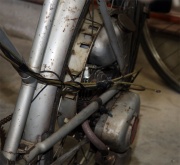Cyclemaster





Cyclemaster were motorcycles produced from 1950 to 1960 by EMI at Hayes in Middlesex.
1950 Production of a motor, made to Dutch design, started. It was a cycle attachment sold as a complete rear wheel that replaced the normal bicycle one. It comprised a large hub with the whole assembly within it. The 25cc two-stroke engine had a disc inlet valve that drove a countershaft carrying a clutch by chain, with a further chain drive to the hub. The petroil tank sat above and behind the engine, giving the whole a very neat appearance.
1952 Capacity was increased to 32cc.
1952 Advert on this page.
1953 A complete machine was offered along with another version called the Roundsman, built as a delivery bicycle with a large carrier hung over a small front wheel.
1954 Advert on this page.
Cyclemate
1955 The company moved to Chertsey in Surrey and, at a later date, manufacture passed to Britax.
1955 The Cyclemate was produced. This was of moped style – the engine being mounted ahead of the bottom bracket of a bicycle made by Norman.
1956 The firm introduced the Piatti scooter, with a 124cc two-stroke engine and three speeds. It was built as a unit with the rear wheel, with the whole assembly pivoted to provide the rear suspension. The pressed-steel frame was shaped in an inverted bath form to completely conceal the works. Maintenance was simple – the machine was turned on its side.
1958 Although it was, by now, dated, the original engine unit continued to be sold until that year. The Piatti, small and low, had gradually lost favour and was no longer listed after that year.
1960 This was the last year of production for the Cyclemate.
See Also
Sources of Information
- The British Motorcycle Directory - Over 1,100 Marques from 1888 - by Roy Bacon and Ken Hallworth. Pub: The Crowood Press 2004 ISBN 1 86126 674 X
- [1] History World










